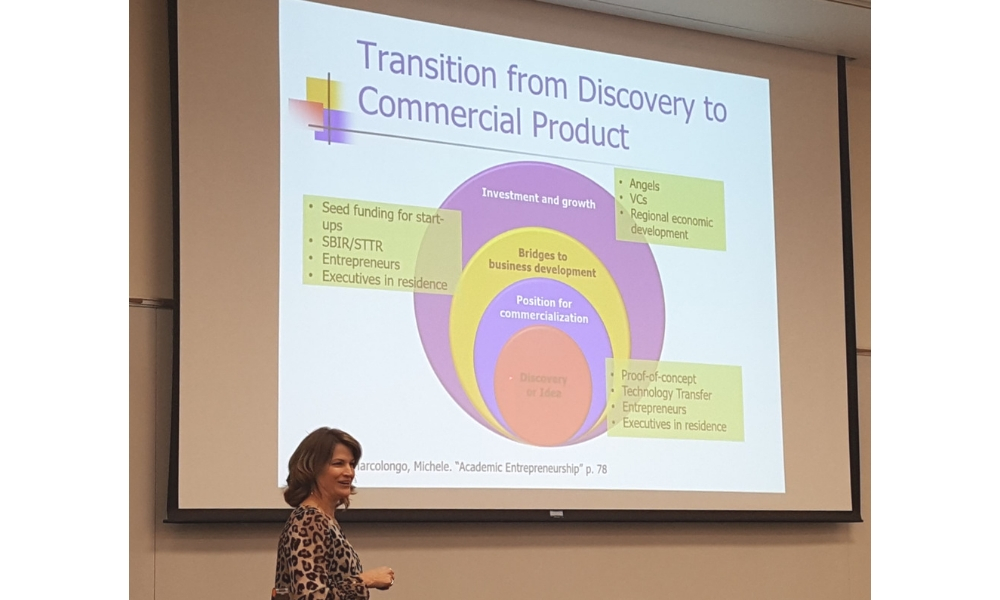From the Lab to the Marketplace
Creating a Student Culture of Innovation
Office of Technology Innovation and Economic Development
By Ben Delp (‘05), JMU Research & Scholarship
More than 50 JMU students studying chemistry and biochemistry attended The Innovation and Entrepreneurial Path: A Roadmap for Life’s Ventures, a seminar designed to shed light on how an idea moves from the laboratory to the marketplace. Led by JMU’s Executive Director of Technology Innovation & Economic Development, Mary Lou Bourne walked the students through the different components of the research and discovery cycle – from funding sources, to research and discovery, to disclosure and patenting, to licensing, to entrepreneurship and company growth leading to reinvestment in research which fuels the research funding cycle.
The Office of Technology Innovation & Economic Development (TIED) is one of a growing number of campus resources for both faculty and students interested in learning how to navigate the innovation and entrepreneurial ecosystem. When asked what role the TIED office performs when students arrive with questions, Ms. Bourne explained that first and foremost, her office serves to educate and inform students about the importance of intellectual property for inventors and entrepreneurs, “When a student comes to see me with an idea to find out how the patent process works, they learn not only about filing a patent application but also how to research patents to find “prior art” (anything that is similar to their idea) in order to create new value in the marketplace. Students see firsthand how to search for competitors by using patents and other business literature as research tools. Having knowledge of what exists helps inventors to distinguish their work from others, and to be more confident that they are not infringing on someone else’s patent. I tell them that they want to do their homework to know their competition and unique value proposition before they pay attorneys to file a patent application or pitch to angel investors to fund their startup company.”
Following this charge to educate and prepare students, Ms. Bourne’s seminar introduced the critical elements of the innovation process, utilizing an established model to assess if an idea is worth pursuing. The NABC Model, developed by one of JMU’s neighbors – SRI (the research institute headquartered in Menlo Park, CA with a facility in Rockingham County) – includes four factors for the innovator to consider:
- Needs
What is the pain or the need in the marketplace? - Approach
How is the pain being addressed, i.e., what is the unique approach? - Benefits
What are the benefits per costs? - Competition
Who is the competition? What prior art already exists?
A JMU resource to assist a budding innovator and entrepreneur is the Innovation & Entrepreneurial Path, a detailed infographic developed by TIED that defines the roles of offices and individuals, as well as specific tasks, as an idea moves down the road from discovery and disclosure to market fit and launch. For more information or to access this resource, please contact Mary Lou Bourne.
After a discussion about the different forms of intellectual property (patents, copyrights, trademarks, and trade secrets), Ms. Bourne profiled one of the most influential innovators in U.S. history to demystify the essential elements of a patent and demonstrate prior art research. From the U.S. Patent & Trademark Office’s website, Ms. Bourne displayed patents granted to Dr. Robert Langer – a chemical engineer with upwards of 1,350 patents, one of only 10 Institute Professors at the Massachusetts Institute of Technology, and the most cited engineer in history. The search revealed Dr. Langer’s most recent patent had been granted just that week (Feb. 12th), though the initial filing occurred in August of 2013, demonstrating the timeline associated with the patent filing process to protect intellectual property.
Bringing the conversation back to JMU, Ms. Bourne described the research and innovation journey of two former JMU professors, Dr. Reid Harris (Biology) and Dr. Kevin Minbiole (Chemistry and Biochemistry). An expert on population ecology with a research focus on fungal infections decimating salamander populations, Dr. Harris, in collaboration with Dr. Minbiole, discovered that naturally occurring bacteria could shield amphibians from the deadly fungus. Conversations with Ms. Bourne about intellectual property protection, led to a discussion about other fungal infections that could be treated using this novel intervention. After prior art research to see if others were working in this space and further research in the lab, the researchers discovered that the same bacteria could treat athlete’s foot fungus and other human skin diseases.
The patent application was filed in 2009 by James Madison Innovations, Inc., JMU’s affiliated non-profit intellectual property management organization. A patent was granted in 2013 and licensed to a start-up company, DermBiont, Inc. in 2017. The Boston-based biotechnology firm, whose foundational roots trace back to labs at James Madison University, currently employs more than 15 scientists and senior business leaders. Ms. Bourne commented that there are a growing number of resources available to students seeking to stay in the area and launch their company, “One of the primary goals of those working to advance the innovation ecosystem is to show students that Harrisonburg and the surrounding communities can support their 21st century businesses and ideas, from space for prototyping, to regional and statewide angel investor networks, to co-working facilities.”
The session concluded with a lively Q&A, with the students departing the seminar with a sense of excitement, eager to dream big and keep the innovation and entrepreneurial path in mind when exploring science-based solutions for the challenges facing the world.
Dr. Barbara Reisner and Dr. Kevin Caran, faculty in the Department of Chemistry and Biochemistry, organized student participation in the seminar.
